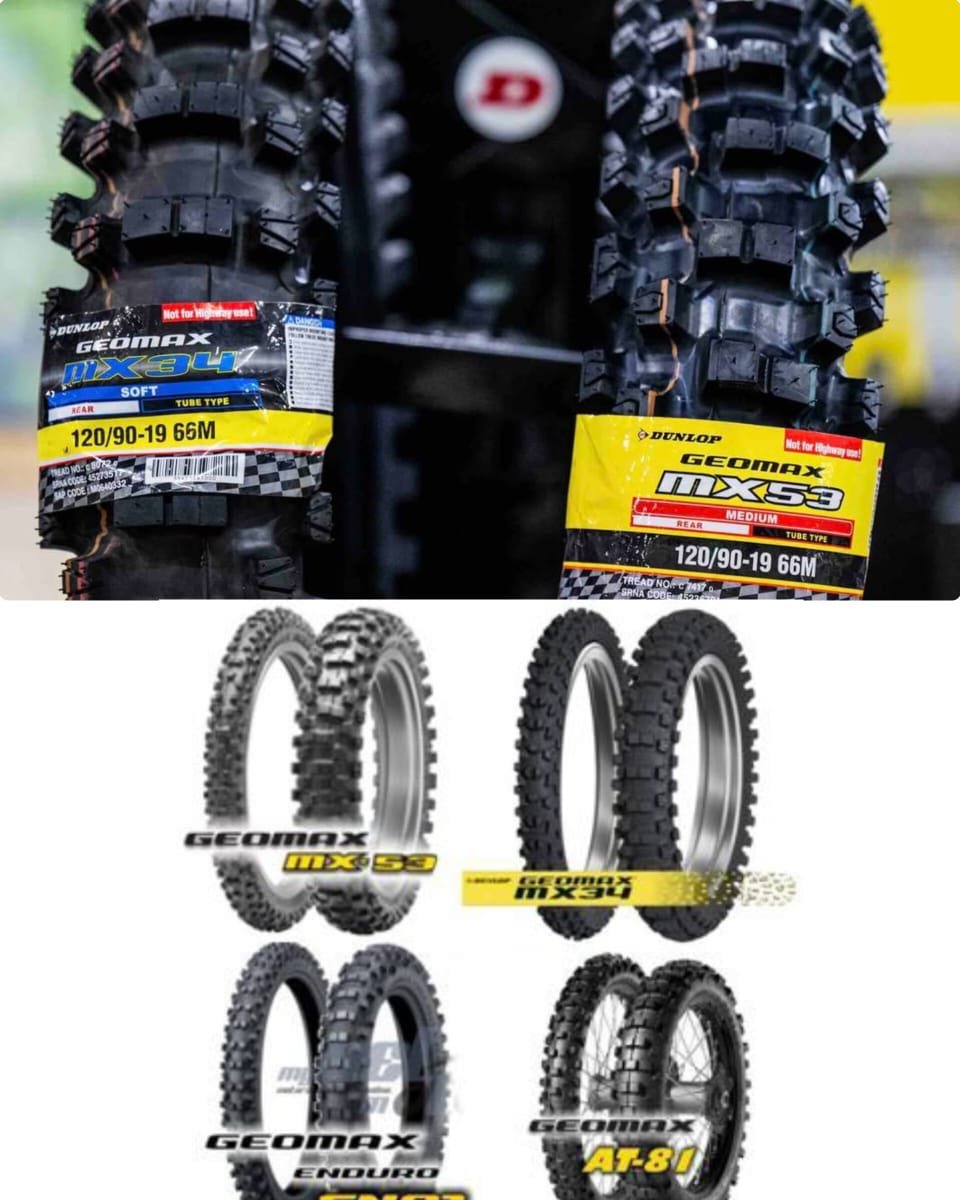The subject “To Scoop or not to Scoop” has been the biggest question in the world of professional motocross and other racing disciplines as of late. I had the opportunity to ride with three different Dunlop rear tire specs back-to-back at Glen Helen Raceway in order to see which one genuinely provides the finest feel and the fastest lap speeds. I performed three-lap sprints on each tire in the morning, in the middle of the day, and in the afternoon, with ML on the stopwatch, in order to evaluate performance over a variety of different track conditions. Did a single tire take the lead from the beginning to the end? Have a look at the following!
Beginning with the Dunlop MX34, which is the replacement to the MX33 and is currently the standard tire on several production bikes, we began our examination. PCBT, which stands for progressive cornering block technology, is a novel innovation that enhances the vehicle’s grip and sensation when turning corners. In addition, the rear tire pattern has been modified, and the center block has been made 11% taller and 44% broader in order to improve traction and control respectively. In addition to the fact that it is more expensive, the fact that it is about one pound heavier than the MX33 is one of the reasons why Yamaha has not yet shifted to using it on their stock models. After conducting tests on the 120/80-19 size, we discovered that the 120/90-19 version is almost a pound lighter than the 120/80-19.
Following that was the MX53, which was intended to be an all-around tire that could be used on a wide range of terrains. It performs admirably in hardpack conditions, but it gives a satisfactory performance in intermediate circumstances.

Finally, we put the MX14 scoop tire through its paces. This tire has been gaining a lot of popularity in the professional motocross and SMX racing circuits, and many of the best riders, notably Eli Tomac, have been utilizing it to win championships. The new MX14 is said to have enhanced adaptability across a wider range of situations, and it was developed specifically for soft terrain such as sand and mud.
Having not spent a significant amount of time on the MX14 before to this, I was intrigued about how it would feel, particularly in the conditions that prevailed at Glen Helen in the early morning hours. When compared to the other two tires, it felt like it was several miles per hour faster moving down the straightaways. This came as a surprise to me because it provided outstanding traction out of bends and impressive forward drive. An improved lean angle was maintained by the MX34 in ruts, which resulted in the highest level of cornering stability. The MX53, on the other hand, had difficulty gaining grip early in the day; I would lose traction when exiting corners, and I had to reduce my throttle pressure in order to maintain control of the vehicle. On the other hand, the stopwatch revealed that I was 1.4 seconds quicker on the MX14, despite the fact that the MX34 was effortless and consistent to corner with. My confidence was higher with the MX34 because to its dependable grip, despite the fact that the lap timings of the 34 and the 53 were comparable.
When compared to the morning, the track produced more defined lines, mild bumps, and less depth by the time it reached the middle of the day. Despite the fact that the conditions had changed, the MX14 continued to be my favorite choice since it provided excellent traction and outstanding driving performance both up slopes and across straightaways. A more accurate relationship between the throttle and the rear wheels resulted in a ride that was both smoother and more stable. The MX34 continued to perform admirably in corners, whereas the MX53 continued to be unpredictable and periodically began to lose control of the vehicle. My fastest lap was once again accomplished on the MX14.
The Morning Session With Lap Times
MX34 | 1:56.17 | 1:56.99 | 1:56.59
MX53 | 1:56.10 | 1:57.10 | 1:56:11
MX14 | 1:54.74 | 1:54.26 | 1:54.74
Session at the Midday
MX14 | 2:00.67 | 1:58.82 | 1:59.31
MX53 | 1:58.99 | 1:59.65 | 1:59.02
MX34 | 1:58.25 | 1:57.82 | 1:57.84
Afternoon Session
MX34 | 1:59.79 | 1:59.23 | 2:00.37 MX53 | 2:00.82 | 2:01:01 | 2:02.52 MX34 | 1:59.79 | 1:59.23 | 2:00.37
| 1:59.30 | 1:58.37 | 1:58.47 | MX14 | Duration:
In the late afternoon, the track was blown out, dry, and rocky…classic Glen Helen conditions that many dread, but I actually enjoy. I had the presumption that the MX14 would begin to fall short in this regard, but I was wrong. It still offered the best traction, even on hardpack, and stayed planted on the rough uphills. That said, the taller and stiffer tread made the rear end feel a bit harsh over bumps compared to the 34 and 53. Still, I felt fastest and most comfortable on the MX14, a big surprise to me. The MX53 offered the least traction and made it toughest to hold a line or hook up under power. The MX34 once again proved consistent and was the easiest to lean and corner with, especially in ruts. But even in these harsh conditions, the stopwatch confirmed: the MX14 was fastest.
To summarize, I found this to be an invigorating examination. Coming from a Yamaha production testing background, I rarely get to evaluate different tire options like this, since OEM specs are pre-determined. Having the opportunity to ride three different tires across a full day and focus solely on performance was a unique and valuable experience. All three tires had their strengths and weaknesses, and I’d feel comfortable riding any of them all day. But for Glen Helen’s range of conditions, the MX14 stood out as the best overall performer—and now I understand why Tomac has even run it in hardpack races.
Leave a Reply